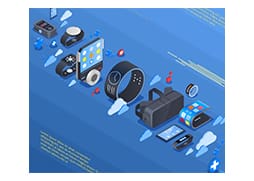In our daily life, PCB play a key role in many common household items and devices, such as appliances, phones, tablets and TVs. They are also used in more specialized equipment, such as medical equipment, fitness trackers, and smart home systems, all of which use PCBs as the mainstay to realize various intelligent functions.
Smart Home Appliances
Smart home appliances are a fast-growing sector in the field of home appliances. Devices are connected to the Internet, allowing users to control them remotely and receive real-time information. The functions of smart home appliances are becoming more and more complex, and the main components to realize these functions are derived from pcbs.

Refrigerator: Control system for refrigerator compressor, ice maker, temperature control and defrost timer.
Washing Machine: Washing machine functions such as wash and spin cycles, water level sensor, balance detection and time setting.
Dishwasher: Various functions of the dishwasher, such as water temperature, detergent dispensing and cycle time.
Air Conditioning: Fan speed, temperature setting, mode selection (heating/cooling/fan) and antifreeze function.
Microwave Ovens: Magnetrons that generate microwave radiation, touch screen interfaces, timers, and safety interlocks.
Oven: The temperature and various functions of the oven, such as bake, grill and self-cleaning cycles.
Coffee Machine: Functions such as automatic on/off, temperature setting, brewing time and heating plate control of the coffee machine.
Dishwasher: handles all cycle controls such as normal/power wash, rinse temperature selection, time setting and water level detection.
Vacuum Cleaners: control functions such as suction power, brush roll activation, stirring rod speed and automatic shut-off function.
Electric Fan: used to control the speed and oscillation of the electric fan
Refrigerator: The temperature and various functions of the refrigerator. and control of the defrost cycle.
Water Heater: The temperature and various functions of the water heater, such as the heating element, thermostat, and safety features.
Audio
The transition from analog audio to digital formats such as cd, mp3, and later high-resolution digital audio files revolutionized the recording industry. Digital audio provides higher fidelity, wider dynamic range and greater flexibility, and the ever-growing audio field cannot do without high-quality pcb manufacturing and assembly to realize complex functions.

Mixers and Audio Interfaces: Mixer functions such as input and output stages, tone controls, and effects. The various functions of the audio interface, including analog-to-digital and digital-to-analog conversion, input and output stages, and buffer amplifiers, also rely on PCBs to implement functions.
Amplifier: Amplifiers and headphone amplifiers both use PCBs to route power and audio signals, including input and output stages, power supply, and tone controls.
Speakers: Connecting different components such as tweeters, woofers, and crossover networks, the PCB is used to control and adjust various functions of the speakers, including crossover networks, amplifiers, and protection circuits.
Microphones: Both condenser and dynamic microphones require various components to be connected and mounted to control and adjust various functions of the microphone, including preamplifiers, filters, and output stages.
Headphones: The headphone driver needs to be connected to the cable and controls, using the PCB to control and adjust the various functions of the headphones, including the driver circuit, amplifier and controls.
Effects Processors: Devices such as reverb units, compressors, and equalizers require high-quality PCBs to connect audio signal paths, controls, and power supplies.
Synthesizers: Analog and digital synthesizers for interfacing oscillators, filters, envelopes, and other components.
Recording Equipment: tape decks, SSD recorders, analog tape decks, etc.
Digital Audio Workstation (DAW): Controlling and adjusting the various functions of a DAW, including input and output stages, digital signal processing, and data transmission are all inseparable from high-quality PCB fabrication.
Floor Care
In floor care equipment, the pcbs are typically designed to be as small as possible in order to save space, They still have to be able to accommodate all of the necessary components and provide good electrical connections. In addition, the pcbs used in floor care equipment must be able to withstand the harsh environments in which these devices are used, including exposure to dust, water, and other debris.

Zhiheng Xingsheng PCB can realize the functions in the field of floor care
Vacuum Cleaners: Motors, lights, switches, and other components for upright and canister vacuum cleaners.
Floor Polishers: Both manual and electric floor polishers include features for controlling speed, direction of rotation, and more.
Scrubber Dryers: Multi-functions for large floor cleaners, such as scrubbing brushes, vacuum systems, spray systems, and push-button controls.
Carpet Cleaners: Both portable and vehicle-mounted carpet cleaners contain functions that require PCBs to control pumps, heaters, and vacuum systems.
Steam Mop: The mop that produces steam has the functions of heating element, temperature, steam output.
Robot Vacuum Cleaner: Modern robot vacuum cleaners require multiple PCBs to control the navigation system, independent wheels, suction motor and charging system.
Sweepers: Both hand and ride-on sweepers include control panels that control functions such as brush height adjustment, suction system, and travel speed.
Polishers: Manual and automatic floor polishers use PCBs to regulate motor speed, control pads, battery charging, and other systems.
Mop Wringers: The features of electric and manual mop wringers allow for functions such as controlled wringing action, safety switches and error detection.
These functions require high-quality PCB manufacturing and assembly to achieve.

